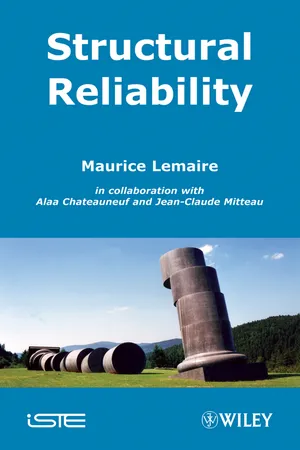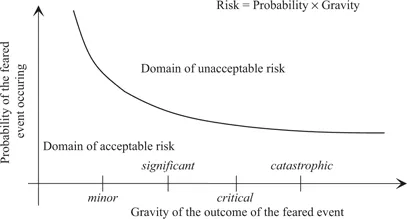
This is a test
- English
- ePUB (mobile friendly)
- Available on iOS & Android
eBook - ePub
Structural Reliability
Book details
Book preview
Table of contents
Citations
About This Book
This book describes the main methods used in the reliability of structures and their use in the design process leading to reliable products. This title provides the understanding needed to implementthevariety of new reliability software programs.
Frequently asked questions
At the moment all of our mobile-responsive ePub books are available to download via the app. Most of our PDFs are also available to download and we're working on making the final remaining ones downloadable now. Learn more here.
Both plans give you full access to the library and all of Perlego’s features. The only differences are the price and subscription period: With the annual plan you’ll save around 30% compared to 12 months on the monthly plan.
We are an online textbook subscription service, where you can get access to an entire online library for less than the price of a single book per month. With over 1 million books across 1000+ topics, we’ve got you covered! Learn more here.
Look out for the read-aloud symbol on your next book to see if you can listen to it. The read-aloud tool reads text aloud for you, highlighting the text as it is being read. You can pause it, speed it up and slow it down. Learn more here.
Yes, you can access Structural Reliability by Maurice Lemaire, Alaa Chateauneuf, Jean-Claude Mitteau in PDF and/or ePUB format, as well as other popular books in Technology & Engineering & Civil Engineering. We have over one million books available in our catalogue for you to explore.
Information
Chapter 1
Introduction
1.1 An old history
It would be fascinating to take some time to go back in history in order to understand how man gradually conquered enough ‘certainties’ to accept rationally the risk of his uncertainties. We will find that great personalities have reflected on this question and contributed to the gradual acquisition of more comprehensive heuristic and axiomatic information, which has made it possible to design more and more ambitious structures and systems.
It is certainly Hammurabi’s code that first established rules governing the acceptance of risk in construction.1 Around 1755 B.C., this Babylonian sovereign put together a set of prescriptions, dictated by the gods, constituting the first legal code ever known. It remained in force in Mesopotamia for a thousand years. The code related to the construction of houses, and the mason’s responsibility was strongly binding.2 Let us judge for ourselves:
Article 229: If a mason has constructed a house for someone but has not strengthened his construction, and if the house that he has constructed collapses and kills the house owner, that mason shall be put to death.
Article 230: If it is the child of the house owner that has been killed, one of the mason’s children shall be put to death.
It is interesting to note that the insistence on safety was then based on the transfer onto the builder of a risk that related to his own security: linking the notion of risk to the outcome of the feared event remains quite a contemporary mindset.
In fact, risk is defined by the existence of a feared event that has a probability (or a possibility) of occurrence, and by the gravity of the consequences of this event.
The following equation is often given:
Risk = Probability × Gravity.
In order to diminish the probability of an event feared by the user, the penalty should be increased for the person who takes the responsibility for the construction. This is a direct application of the Farmer graph illustrated in Figure 1.1, according to which the mason will try to reduce the probability of the occurrence of a feared event if its consequences are disastrous for him.3
Figure 1.1 Farmer graph (1967): probability-gravity.

Hammurabi imposed responsibility for results and left the choice of the means of achieving them open. He anticipated what the European Union would much later call directives. Today this practice seems barbaric, whereas it essentially aimed at limiting the effects of an endless vendetta between the concerned parties due to the application of the law of ‘an eye for an eye’.
Humanity’s scientific quest therefore consisted of accumulating experience and constructing projected models that give today, not for one man but collectively to engineers, the possibility of taking on the risks of civil and mechanical constructions on behalf of society with real success, in a context in which great catastrophes are a reminder that humility is always necessary.
1.2 A modern attitude
If the knowledge of geometry and static mechanics advanced rapidly in ancient times, the mastery of the uncertain in the construction of cathedrals in the Middle Ages proceeded by trial and error and led to well-known failures.4 Leonardo da Vinci (1452–1519) was one of the first to look for a relationship between load effect and resistance in the case of beams. A little later, Galileo was particularly interested in the optimization of the resistance of a cantilever beam, thereby initiating the first modeling.5
We know the great developments in modeling the behavior of materials and constructions that followed. This conquest could lead us to believe that one day the knowledge of laws, models and solutions will attain such perfection that engineers will be able to trust them completely. However, in parallel and sometimes simultaneously, scientists explained that we should live with chance.
Should we return to a philosophical debate by wondering whether chance exists, or whether what we call chance is only the fruit of our ignorance and our inability to take into account all the initial conditions of a process? Using the language of fluid mechanics, the Lagrange approach to chance is impossible because it requires monitoring a trajectory, whereas the Euler approach is content to observe the variability at the time and the place where the observer is placed. This debate is certainly futile for us today, and it is no doubt more pragmatic to think that between the present mastery of knowledge and physical reality, there will always be a gap that cannot be modeled with certainty. Moreover, we all know very well that very small disturbances of an initial state can lead to huge potential differences in the consequences, as seen in the phenomena of instability, for example in meteorology or in structural mechanics.
On the other hand, perfectly determined outcomes can be predicted by methods based on the modeling of uncertainty. This is the case for geostatistics, for example, where the content of an ore is considered a unique outcome of a random process.
In view of this inability to master all the data – which he possesses in theory, however, as they are in front of him and he has only to know how to read them – man gambles, and most often he wins.
Blaise Pascal (1623–1662) invites us to reflect on this theme:
when we work for tomorrow, and do so on an uncertainty, we act reasonably; for we ought to work for an uncertainty according to the doctrine of chance which has been demonstrated.
The first part of this proposition is simple. We work for tomorrow using studies that contribute to strengthening scientific progress, to increasing our knowledge of phenomena and to creating models in order to anticipate; we work for the uncertain because all the data will never be at our disposal for sure. Pascal tells us that we do it with reason, and he justifies it by the hope of success. It is therefore important to know what success brings us, and what makes us fear failure. Replying to Chevalier de Méré, Pascal demonstrated how to share – in other words, to give everyone his due – in a game which is subject to risk-taking and hopes of success. The doctrine of chance therefore enables each person to justify his commitment depending on his hopes.
This pensée by Pascal regarding a commercial stake can also be applied relevantly to a technical context. In his quest for knowledge, in his desire to want to achieve the most daring of constructions or machines, man takes risks, hoping for progress, for the benefit of humankind. Thus, Pascal made a contribution to decision-making in uncertainty, by showing that chance, whatever its origin, has a geometry: Pascal thereby laid the foundations for the calculation of probabilities.
If everyone accepts the uncertainty of data, the uncertainty of models has only recently been admitted.
One of the most powerful drivers in the advancement of science was the observation of the solar system, as much by what it induced in terms of the capacity for precise measurements as in the capacity for modeling. Until the end of the 19th century, the majority of astronomer–mathematicians were searching for mathematical laws to describe the movement of the planets, particularly in terms of the well-known problem of three bodies in gravitational interaction (sun, earth, moon). According to them, it would have been enough to add to the main components of movement successive corrections brought about by weak perturbations, in order to obtain exact predictions of the ephemerids. The works of Henri Poincaré, on the occasion of the award given in 1889 by the King of Sweden and Norway, Oscar II, led to a conclusion accepted with difficulty: unpr...
Table of contents
- Cover
- Title Page
- Copyright
- Foreword
- Preface
- Chapter 1: Introduction
- Chapter 2: Preliminary Approach to Reliability in Mechanics
- Chapter 3: Elementary R − S Case
- Chapter 4: Isoprobabilistic Transformation
- Chapter 5: Reliability Index
- Chapter 6: Products of Reliability Analysis
- Chapter 7: Probability of Failure
- Chapter 8: Simulation Methods
- Chapter 9: Reliability of Systems
- Chapter 10: ‘Safety’ Coefficients
- Chapter 11: Mechanical-Reliability Coupling
- Chapter 12: Stochastic Finite Elements
- Chapter 13: A Few Applications
- Chapter 14: Conclusion
- Bibliography
- Annotations
- Index